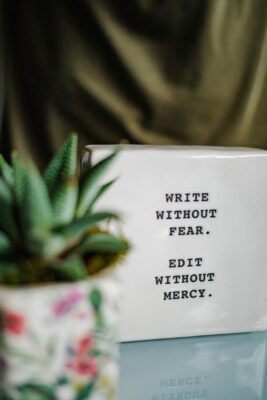
While writing is like a joyful release, editing is a prison where the bars are my former intentions
and the abusive warden my own neuroticism.
~ Tiffany Madison
You press SAVE as you glance at the sunset, just visible outside your window through flickering palm leaves.
Finally! The End.
You’ve finished the first draft of your manuscript. Pat yourself on the back. Congratulations!
Now comes the hard part.
Editing.
Truth be told, I’ve learned about editing a manuscript the hard way.
I don’t know about you, but typing is not one of my strong points. I refused to take typing in high school, although Mom insisted that I needed the class. However, she didn’t expect my brothers to do the same … . Thus, I am a terrible typist these days, prone to making embarrassing errors in my writing.
So, editing sometimes seemed to me like plodding through quicksand or knee-deep snow.
Every writer eventually finds their own system for working with manuscripts. After some rather discouraging experiences, I quickly realized that an editing checklist would come in handy. And it has.
WHAT ABOUT A CHECKLIST?
Consider creating a checklist best suited to your genre.
Ask yourself what issues have proven problematic for you in the past. What do you forget to look at closely in a manuscript? What things have readers pointed out to you that needed attention?
I find myself periodically adding to my checklist. As I gain more experience and know-how, I see what changes I must make. My checklist contains twenty items I deem crucial to my work as a writer of nonfiction, primarily because my manuscripts usually contain numerous bibliographical citations and quotations from historical sources. Of course, fiction writers and poets have other criteria for their manuscripts. And their checklists will differ somewhat from the following, which serves only as a template. You’ll find numerous examples of editing checklists on the internet, which may help you to formulate your own list. And Elizabeth K. Kracht’s The Author’s Checklist: An Agent’s Guide to Developing and Editing Your Manuscript offers another possible option for firming up your own checklist, as well as checklists for publishing, too.
CREATING YOUR CHECKLIST
 Wade through your draft, focusing on one aspect at a time as you edit, searching for:
Wade through your draft, focusing on one aspect at a time as you edit, searching for:
-
- typos
- spelling errors—spellcheckers are great, but …
- subject/verb agreement
- issues with commas, periods, colons, hyphens, numbers written out (or not)
- overuse of phrases and words
- improper capitalization of words
- sentence structure and variation (please!)
- mixed metaphor or similes
- useless words—tighten up the text—get rid of things like “daughter of Anna” and write “Anna’s daughter” instead
- incorrect spacing between words
- confusion of names and dates associated with characters
- facts and bibliographic citations in need of double-checking
- missing italics or improperly italicized words
- inconsistent use of quote marks (“curly” or “straight”)
- passive voice, or too many uses of “was,” “were,” “is,” “had,” etc.
- too many sentences beginning with “And” or “But”
- incorrect use of apostrophes
- line spacing
- comma usage
- that/which confusion
TOOL FOR EASE OF EDITING
When editing, FIND is your friend, but don’t count too much on it or on SPELLCHECK.
WORD’s editing assistant, EDITOR, works quite well, too. I turn it on as I write, so I often catch a lot of mistakes before I even finish the first draft. In addition to EDITOR, I rely on Grammarly. You’ll find numerous other editing tools available, some better than others, some more damaging to your wallet.
 Whatever tool you use, or don’t use, there’s no substitute for a good, slow slog through the manuscript. Again, try focusing on just one item at a time from your checklist. Some techniques for unearthing problems include:
Whatever tool you use, or don’t use, there’s no substitute for a good, slow slog through the manuscript. Again, try focusing on just one item at a time from your checklist. Some techniques for unearthing problems include:
- starting with the old line-by-line trick. Use a ruler to hide the next lines. That way, you’re forced to focus on just one line at a time.
- scrolling through your manuscript backward, from the bottom of the page to the top.
- reading your manuscript out loud.
- highlighting questionable usage in red.
With time, you’ll discover what works best for you.
And, again, congratulations on finishing your manuscript! And enjoy the sunset.
[Editor’s note: WAG would love to see articles on any and all topics of interest to writers. Please send your ideas or finished pieces to Cynthia D. Bertelsen at BlogEditor@writersalliance.org for consideration. Remember: these posts are more than just posts, for they are actual articles and can be cited in your CV/résumé in the same way you would a short story, essay, or any other writing credit you may possess.]

Jess Elliott
Excellent list! Great article.